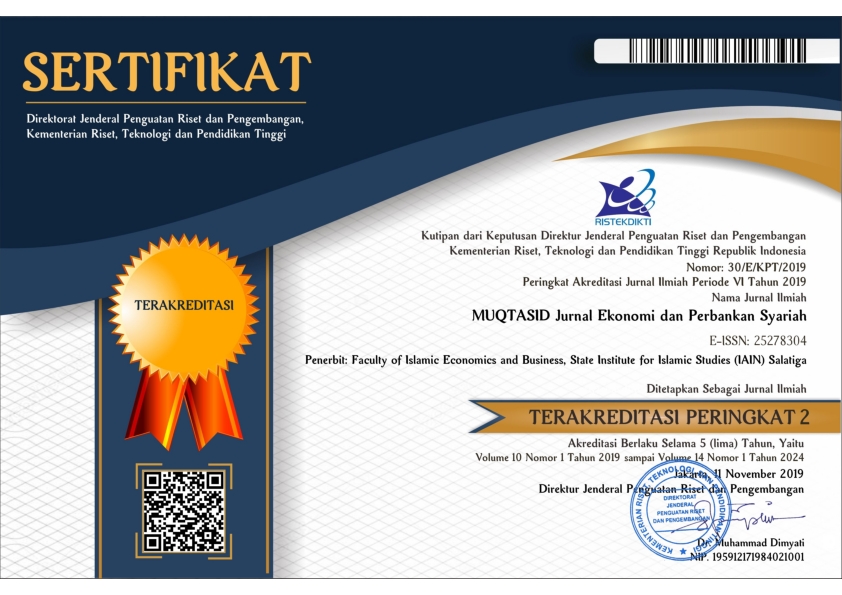Investment, Deposit Interest Rates, and Real Sector Performance: A Case Study of Islamic Finance in Malaysia
Abstract
This study aims to examine the influence of interest rates, GDP, consumption, and investment on Islamic finance in Malaysia. Also, it focuses on the causal relationship between the macroeconomic and humanistic approach in understanding the role of Muslim economics. Data were analyzed using the Vector Error Correction Model and the results showed that interest rates negatively affect the real sector. Therefore, the Islamic financial system with a zero or no interest-based interest rate tends to promote a social economy
Keywords
Full Text:
PDFReferences
Alexakis, C., Izzeldin, M., Johnes, J., & Pappas, V. (2019). Performance and Productivity in Islamic and Conventional Banks: Evidence from the Global Financial Crisis. Economic Modelling, 79(6), 1-14. https://doi.org/10.1016/j.econmod.2018.09.030.
Amin, S., & Alam, I. (2008). Women's Employment Decisions in Malaysia: Does Religion Matter?. The Journal of Socio-Economics, 37(6), 2368-2379. https://doi.org/10.1016/j.socec.2008.04.012.
Aziz, S., Ashraf, D., & El-Khatib, R. (2021). Societal Trust and Sukuk Activity. Journal of International Financial Markets, Institutions and Money, 74(9),138-48. https://doi.org/10.1016/j.intfin.2021.101384.
Bhuiyan, R. A., Rahman, M. P., Saiti, B., & Ghani, G. B. M. (2019). Does the Malaysian Sovereign Sukuk Market Offer Portfolio Diversification Opportunities for Global Fixed-income Investors? Evidence from Wavelet Coherence and Multivariate-GARCH Analyses. Economics and Finance, 47(1), 675-687. https://doi.org/10.1016/j.najef.2018.07.008.
Billah, M. M. (2019). Islamic Financial Products Principles Instruments and Structures. Cham: Palgrave Macmillan.
Chen, D. L., & Hungerman, D. M. (2014). Economics, Religion, and Culture: A Brief Introduction. Journal of Economic Behavior & Organization,104(8), 1-3. https://doi.org/10.1016/j.jebo.2014.04.008.
Elhaj, M. A. A., Muhamed, N. A., & Ramli, N. M. (2015). The Influence of Corporate Governance, Financial Ratios, and Sukuk Structure on Sukuk Rating. Procedia Economics and Finance, 31(1), 62-74. https://doi.org/10.1016/S22125671(15)01132-6.
Gundogdu, A. S. (2016). Islamic Electronic Trading Platform on Organized Exchange. Borsa Istanbul Review, 16(4), 249-255. https://doi.org/10.1016/j.bir.2016.06.002.
Guzhva, V. S., Raghavan, S., & D'Agostino, D. J. (2019). Aircraft Leasing and Financing: Tools for Success in Aircraft Acquisition and Management. Amsterdam: Elsevier.
Hare, C., & Neo, D. (2021). Trade Finance: Technology, Innovation and Documentary Credits. Oxford : Oxford University Press.
Juhro, S. M., Narayan, P. K., Iyke, B. N., & Trisnanto, B. (2020). Is There a Role for Islamic Finance and R&D in Endogenous Growth Models in the Case of Indonesia?. Pacific-Basin Finance Journal, 62(9), 129-137.https://doi.org/10.1016/j.pacfin.2020.101297.
Kassim, S. (2016). Islamic Finance and Economic Growth: The Malaysian Experience. Global Finance Journal, 30(5), 66-76. https://doi.org/10.1016/j.gfj.2015.11.007.
Khan, A., Rizvi, S. A. R., Ali, M., & Haroon, O. (2021). A Survey of Islamic Finance Research Influences and Influencers. Pacific-Basin Finance Journal, 69(10), 1-14. https://doi.org/10.1016/j.pacfin.2020.101437.
Kumar, S., Sahoo, S., Lim, W. M., & Dana, L. P. (2021). Religion as a Social Shaping Force in Entrepreneurship and Business: Insights from a Technology-empowered Systematic Literature Review. Technological Forecasting and Social Change, 175(2), 1-12. https://doi.org/10.1016/j.techfore.2021.121393.
Morrell, P. S. (2021). Airline Finance. London: Routledge.
Mutuku, C. (2018). Islamic and Western Banking Paradigms. Berlin: GRIN Verlag.
Oseni, U. A., Adewale, A., & Zain, N. R. B. M. (2016). Customers' Perceptions on the Dispute Resolution Clauses in Islamic Finance Contracts in Malaysia. Review of Financial Economics, 31(11), 89-98. https://doi.org/10.1016/j.rfe.2016.05.004.
Qoyum, A., Sakti, M. R. P., Thaker, H. M. T., & AlHashfi, R. U. (2021). Does the Islamic Label Indicate Good Environmental, Social, and Governance (ESG) Performance? Evidence from Sharia-compliant Firms in Indonesia and Malaysia. Borsa Istanbul Review, https://doi.org/10.1016/j.bir.2021.06.001.
Salem, R. A. (2013). Risk Management for Islamic Banks. Edinburgh: Edinburgh University Press.
Salman, A., & Nawaz, H. (2018). Islamic Financial System and Conventional Banking: A Comparison. Arab Economic and Business Journal, 13(2), 155-167. https://doi.org/10.1016/j.aebj.2018.09.003.
Sandwick, J. A., Hassan, M. K., & Collazzo, P. (2021). A Guide to Islamic Asset Management Portfolio Investing with Sharia. Cheltenham: Edward Elgar Publishing.
Sasongko, B., & Bawono, S. (2020). Financial Crisis and Debt Based Economic, Case Study Global Three Crisis In Asia 5. International Journal of Scientific & Technology Research, 9(12), 129-135.
Sasongko, B., Bawono, S., & Prabowo, B. H. (2021). The Economic Performance of China in Trade War: The Case Study of Three Global Economic Crises in 1997–2020. International Symposia in Economic Theory and Econometrics, 29(2), 1-11. https://
doi.org/10.1108/S1571-03862021000029B022.
Sinclair-Desgagné, B. (2021). Green Human Resource Management A Personnel Economics Perspective. Resource and Energy Economics, 66(11), 1-12. https://doi.org/10.1016/j.reseneeco.2021.101261.
Smaoui, H., Mimouni, K., Miniaoui, H., & Temimi, A. (2020). Funding Liquidity Risk and Banks' Risk-taking: Evidence from Islamic and Conventional Banks. Pacific-Basin Finance Journal, 64(12), 114-136. https://doi.org/10.1016/j.pacfin.2020.101436.
Ren, N. (2021). Transnational Networks and Institutional Embeddedness: Reengagement of the New Generation of Malaysian Chinese Entrepreneurs with China. Asian Journal of Social Science, 49(4), 215-224. https://doi.org/10.1016/j.ajss.2021.09.007.
Uddin, M. H., Kabir, S. H., Hossain, M. S., Wahab, N. S. A., & Liu, J. (2020). Which Firms do Prefer Islamic Debt? An Analysis and Evidence from Global Sukuk and Bonds Issuing Firms. Emerging Markets Review, 44(9), 71-82. https://doi.org/10.1016/j.ememar.2020.100712.
Voll, J. O. (2019). Islam: Continuity And Change In The Modern World. New York: Routledge.
Widarni, E. L, & Bawono, S. (2021). The Comparation of Foreign Financial Investment and Human Investment Effect on Economic in Indonesia Base on Macro Economic Point of View. Estudios de Economia Aplicada, 39(12), 1-14. htpps://doi.org/10.25115/eea.v39i12.6006.
DOI: https://doi.org/10.18326/muqtasid.v12i2.144-154
Refbacks
- There are currently no refbacks.
License URL: http://creativecommons.org/licenses/by-sa/4.0/

MUQTASID by http://muqtasid.iainsalatiga.ac.id/ is licensed under a Creative Commons Attribution-ShareAlike 4.0 International License.
MUQTASID Jurnal Ekonomi dan Perbankan Syariah UIN SALATIGA p-ISSN: 2087-7013, e-ISSN: 2527-8304





